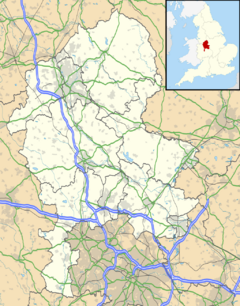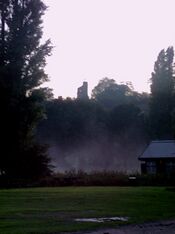Chemistry:Tutbury
| Tutbury | |
|---|---|
 The Dog & Partridge | |
Location within Staffordshire | |
| Population | 3,076 2011 Census |
| OS grid reference | SK211285 |
| District |
|
| Shire county |
|
| Region | |
| Country | England |
| Sovereign state | United Kingdom |
| Post town | BURTON-ON-TRENT |
| Postcode district | DE13 |
| Dialling code | 01283 |
| Police | Staffordshire |
| Fire | Staffordshire |
| Ambulance | West Midlands |
| UK Parliament |
|
Tutbury is a large village and civil parish of about 3,076 residents in the England county of Staffordshire.
It is surrounded by the agricultural countryside of both Staffordshire and Derbyshire. The site has been inhabited for over 3,000 years, with Iron Age defensive ditches encircling the main defensive hill, upon which now stand ruins of a Norman castle. These ditches can be seen most clearly at the Park pale and at the top of the steep hills behind Park Lane.
The name Tutbury probably derives from a Scandinavian settler and subsequent chief of the hill-fort, Totta, bury being a corruption of burh the Anglo-Saxon name for 'fortified place'. It is 5 miles (8.0 km) north of Burton upon Trent and 20 miles (32 km) south of the Peak District.
Quarries near Tutbury once produced alabaster which was used in the carving of Nottingham Alabaster.
Until 2006, Tutbury Crystal, a manufacturer of high-quality cut glass products, was based in the village. However production was transferred to Stoke-on-Trent as the existing factory was very old and was thought to be too small for the modern company's requirements. The old factory was demolished and flats were built on the site, but a factory shop still operates in the village. Despite this, the tourism trade survives thanks to the long and distinguished history of the Norman Priory Church and medieval Tutbury Castle where Mary, Queen of Scots, was once imprisoned.
The castle became the headquarters of Henry de Ferrers and was the centre of the wapentake of Appletree, which included Duffield Frith. With his wife Bertha, he endowed Tutbury Priory with two manors in about 1080. It would seem that Tutbury at that time was a dependency of the Norman abbey of St Pierre‑sur‑Dives.[1] One of the Royal Studs was established in the area round the castle by Henry VIII but had to be abandoned after the Civil War.[2]
Until the 18th century, Tutbury was the site of an annual court of minstrels.[3] There was even a "King of the Minstrels".
There are some fine Georgian and Regency buildings and the half-timbered Dog and Partridge Hotel. There are antique and craft shops in the village some of which have been run by the same families for many years.
Tutbury and Hatton railway station, was opened by the North Staffordshire Railway on 11 September 1848. It then closed during the 1960s to reopen in 1989. It is on the Crewe to Derby Line.
Tutbury Priory Church, dedicated to the Blessed Virgin Mary, has a unique west door with the only known alabaster arch (circa 1160) in the country.[4]
Media
The Natural History of Tutbury describing the fauna and flora of the district surrounding Tutbury and Burton on Trent, by Sir Oswald Mosley and Edwin Brown, was published in 1863.[5]
The village of Tutbury was featured in the Most Haunted spin-off series Most Haunted: Midsummer Murders where the team investigated a murder over hidden treasure.
Notable people
- William de Ferrers, 3rd Earl of Derby (died 1190) was an English Earl who resided in Tutbury Castle
- Robert de Ferrers, 6th Earl of Derby (1239–1279) was an English nobleman, born at Tutbury Castle
- Ann Moore (1761–1813) the notorious fasting-woman of Tutbury. From 1807 to 1813, she claimed to have eaten nothing at all, but her claims were eventually shown to be a hoax.
- Benjamin Brook (1776–1848) an English nonconformist minister and religious historian, the first pastor of the congregational church at Tutbury in 1801
- Walter Lyon (1841–1918 in Tutbury) an English cricketer who played in first-class cricket matches for Cambridge University between 1861 and 1863. In 1865, he and his younger brother Charles moved to Tutbury to take over the cotton mill
- John Henry Davies (c. 1864 in Tutbury – 1927) a wealthy British brewery owner who in 1902 took over the football club Manchester United, which was then called Newton Heath.
- Thomas Richardson (1865–1923) cricketer who played first-class cricket for Derbyshire in 1895. Born and died in Tutbury
- George Harris (born 1877) an English professional footballer who played 71 pro games and on retirement became the landlord of a public house at Tutbury
- Air Vice Marshal William Staton, CB, DSO & Bar, MC, DFC & Bar (1898 in Tutbury – 1983) a WW1 British airman, later WW2 Japanese PoW and senior RAF officer
- Joseph Nelis (1917–1994) a Belgian footballer, was born in Tutbury
See also
- Listed buildings in Tutbury
References
- ↑ Marios Costambeys, 'Ferrers, Henry de (d. 1093x1 100)’, Oxford Dictionary of National Biography, Oxford University Press, Sept 2004; online edn, May 2007 [ 61, accessed 28 Oct 2007]
- ↑ "Some Notes on Foundation Breeders and Early Running Horses". Thoroughbred Heritage. http://www.tbheritage.com/Breeders/FoundBreeders/EarlyNotes.html. Retrieved 2011-10-06.
- ↑ Mosley, Oswald, Sir. History of the Castle, Priory and Town of Tutbury, in the county of Stafford.
- ↑ "CoPAA – Conservation of the Priory Alabaster Arch". St. Mary's Priory Church, Tutbury. http://tutburystmarys.org/priory-projects/copaa. Retrieved 31 March 2019.
- ↑ Mosley, Oswald; Brown, Edwin (1863). The Natural History of Tutbury.
External links
- Information from UpMyStreet
- Map from StreetMap
- Tutbury Community Forum
- Hauntings of Tutbury
- Love Burton Tutbury Page




